Matador Network's Blog, page 846
June 3, 2020
Feeding Black Lives Matter activists

In the aftermath of the death of George Floyd, a black man allegedly murdered after a police officer knelt on his neck for eight minutes after arresting him for (again allegedly) using a counterfeit $20 bill, the entire country rose up to protest police brutality. These demonstrations in support of the Black Lives Matter movement have been peaceful, though some agitation has led to looting and the arrest of around 9,000 people. Many restaurants around the country have voiced their support for protests against the death of George Floyd, and now efforts are popping up around the country to feed protestors.
In Oakland, Black Earth Farms, which describes itself as a “pan African & pan Indigenous farming collective,” has partnered with Raised Roots, a “black-owned urban farming company,” to provide meals to protestors. In an Instagram post, Black Earth Farms wrote that it will deliver food to any black protestors in the area who have been injured, arrested, or bailed out in the course of the demonstrations, which have been ongoing in California since Sunday.
In a subsequent post, Raised Roots wrote that it aims to “distribute free prepared meals to people who need it.” The organization said that it is currently looking for donations and resources, including commercial kitchen access and cold storage but hopes that meal preparation will begin on June 3.
Elsewhere in the United States, the New York Times reports that Maria Acosta, the owner of several McDonald’s franchises in Texas, fed protestors who returned to San Antonio to clean up the damage done during demonstrations, which turned violent. Acosta, along with volunteers, packed “800 meals of chicken nuggets, cheeseburgers and apples,” as crews swept glass and scrubbed graffiti.
Meanwhile, in Minneapolis, Pimento Jamaican Kitchen handed out bags packed with essential items for marchers, including face masks and gauze. Vice News reporter Elizabeth Landers spotted chef and humanitarian José Andrés at a demonstration in Washington DC on Tuesday, where she reports that he was handing out food to his fellow marchers. Subsequent replies to her post from World Central Kitchen CEO Nate Mook imply that the organization will soon be setting up in George Floyd’s home state of Minneapolis, where protesting has been among the most intense in the country. 
More like this News How to support Black Lives Matter protests if you can’t be there in person
The post Restaurants and chefs come together to feed Black Lives Matter demonstrators appeared first on Matador Network.
[image error]
‘Just Mercy’ free to stream in June
In the wake of the George Floyd murder and the protest against police brutality, people are looking for new ways to educate themselves about race issues in the US. Warner Bros. is doing its part to make this education easier, making its 2019 civil rights drama Just Mercy free to stream on digital platforms this month. The movie will be available for free through the end of June on Amazon Prime Video, Apple TV, FandangoNow, Google Play, YouTube, Vudu, and Redbox.
In a statement, Warner Bros. representatives said, “We believe in the power of story. Our film Just Mercy, based on the life work of civil rights attorney Bryan Stevenson, is one resource we can humbly offer to those who are interested in learning more about the systemic racism that plagues our society. For the month of June, Just Mercy will be available to rent for free across digital platforms in the US. To actively be part of the change our country is so desperately seeking, we encourage you to learn more about our past and the countless injustices that have led us to where we are today.”
The movie tells the true story of Bryan Stevenson, a defense attorney played by Michael B. Jordan. In 1989, Stevenson appealed the wrongful murder conviction of Walter McMillan, an African American pulpwood worker from Alabama portrayed by Jamie Foxx. 
More like this Books Purchase your new reading list from these Black-owned bookstores, not Amazon
The post ‘Just Mercy’ will be free to stream this month to promote education on race issues appeared first on Matador Network.

Confederate monument destroyed

Field-specific advice from an Egyptologist usually doesn’t have much practical application. When professor Sarah Parack tweeted instructions on how to tear down an obelisk, however, more than just archeology buffs were listening. Parack, a professor of Egyptology at the University of Alabama at Birmingham, posted the step-by-step instructions from her research on ancient Egypt and suggested that the same method could be applied to more modern-day monuments — specifically, a Confederate monument in downtown Birmingham.
She shared a diagram explaining exactly how to tear down an obelisk, accompanied by the note, “There might be one just like this in downtown Birmingham! What a coincidence. Can someone please show this thread to the folks there.”
Here’s a rough schematic. I note this is experimental archaeology in action! Just my professional Hot Take and you may need more people, longer rope, etc. everything depends on monument size. pic.twitter.com/lzl55CSPNt
— Sarah Parcak (@indyfromspace) June 1, 2020
The instructions called for 40 or more people for every 10 feet of monument, using rope attached to a chain to pull in unison from all sides.
The message wasn’t very cryptic, and people certainly ran with it. That very night, crowds protesting against police brutality gathered in Birmingham and tried to tear down the Confederate Soldiers and Sailors Monument in Linn Park. Randall Woodfin, the city’s mayor, announced via megaphone, “Allow me to finish the job for you,” and called in workers to remove the monument the very next night.
Dedicated in 1905, the monument had been controversial for some time. During a series of protests against Confederate monuments in 2017, Birmingham’s previous mayor ordered the monument to be surrounded by plywood to block it from view, though the plywood was removed last fall after a court order. Woodfin now faces backlash from the state’s attorney general, but appears unworried.
“In order to prevent more civil unrest,” he said, “it is very imperative that we remove this statue in Linn Park.” 
More like this News How to support Black Lives Matter protests if you can’t be there in person
The post Egyptologist tweets guide for destroying an obelisk, protestors use it to tear down Confederate monument appeared first on Matador Network.

National Doughnut Day history

June 5 is National Doughnut Day, and for most people that might signal an opportunity to enjoy a doughnut either as a breakfast snack or delectable dessert. A doughnut is usually not the subject of much deep thought beyond the two minutes it takes to eat one. But the history of the doughnut goes much deeper than you might think, and the designated National Doughnut Day is much more than an excuse to buy a dozen doughnuts for your coworkers. In fact, it actually celebrates the women who braved the front lines of the conflict to fry doughnuts for soldiers under the most inhospitable circumstances.
During World War I, volunteers from the Salvation Army, an all-women group nicknamed the “Doughnut Lassies,” served doughnuts to American Expeditionary Forces serving on the front lines in France, hoping to boost morale and provide a much-needed reminder of home. When it comes to comfort foods, doughnuts have been the MVP since 1914.
According to The National WWI Museum and Memorial in Kansas City, these women served near the front lines and handed out writing supplies, stamps, and hot meals to the soldiers in addition to baking doughnuts. Sometimes they used shell casings to roll out the dough. Because these women risked their lives, National Doughnut Day was established in 1938 to honor their hard work.
“National Doughnut Day isn’t actually a salute to the doughnut but honors the women of The Salvation Army who supported the American Expeditionary Forces during World War I,” explains Lora Vogt, the memorial’s curator of education. “A primary portion of their mission was to help ease the hardships of fighting for US soldiers on the front lines. Needless to say, it is not easy to bake in abandoned buildings and war-torn communities. Two volunteers — Margaret Sheldon and Helen Purviance — saw a need and became innovators as they began frying doughnuts in soldiers’ helmets, up to seven per batch in the beginning.”
Purviance in particular stated that it was her mission to bring a taste of home to soldiers, later stating that “There was… a prayer in my heart that somehow this home touch would do more for those who ate the doughnuts than satisfy a physical hunger.”
According to Vogt, although other baked goods like pies were made, doughnuts were favored because they could be prepared using shelf-stable ingredients and could be fried anywhere that the volunteers could heat oil — no oven needed. The volunteers then served the freshly dried doughnuts to the likely exhausted, homesick soldiers. A doughnut might not heal all their wounds but in times of crisis, a handmade treat can offer a moment of serenity.
The doughnut evolved during this period, too: During the war, many ingredients were rationed on the home front to make sure that enough supplies could be sent to the armed forces. When wheat flour wasn’t available, recipes substituted rye flour, barley flour, and sweet potato flour. Sugar was in short supply too, but corn syrup and molasses came to the rescue. Vogt says that one of the most important lessons to come out of the wartime kitchen is that most recipes are adaptable — including those for doughnuts.
“If short on yeast, consider using sourdough or baking powder as the rising agent,” she adds. “Not so keen on lard? Refined coconut oil is solid at room temperature and has the same shelf-stable qualities.”
If you do plan on enjoying a doughnut on June 5, spare a moment to think about the brave women who upended their lives to provide small but vital comforts to the young who served in France during World War I. Their efforts might seem small, but they understood the power of something as simple as a doughnut to bring joy. 
More like this Dessert The 11 best types of doughnuts served around the world
The post How ‘Doughnut Lassies’ supported front-line troops during World War I appeared first on Matador Network.

Sustainable wellness travel

In the past decade, the wellness travel trend has had a transformative impact on the tourism industry. According to the travel industry news site Skift, wellness tourism is worth about $639 billion worldwide and continues to grow at twice the rate of the tourism industry overall. Yet the way we defined wellness 10 years ago looked a lot different than it does today. What started with kale juice and counting steps has evolved to encompass everything from astrology-guided drunk yoga to orgasm workshops.
It makes sense. Travel can feel like a blank slate. An opportunity for education and altering habits. A break from routine that creates the time and space we need to focus solely on being our best selves. And the more we dig into what it means to be well, the more apparent it becomes that we cannot be healthy if our planet is not. In the years to come, if we want our wellness retreats to come with things like clean water, fresh air, and nutrient-rich food, we need to raise our standards for sustainable wellness travel. Asking yourself these questions below before you book future wellness travel will guide you toward eco-friendly experiences that meet a much-needed new standard of sustainability.
How is the resort protecting its local ecosystem?
According to the United Nations’ Global Sustainable Tourism Council (GSTC), destination stewardship is the process by which hotels and resorts help preserve the attributes that make a destination attractive to tourists. This means preserving local plants and wildlife, as well as the cultural heritage of a place. When booking a wellness retreat, find out what the resort is doing to protect the local ecosystem from which it — and you — are benefitting.
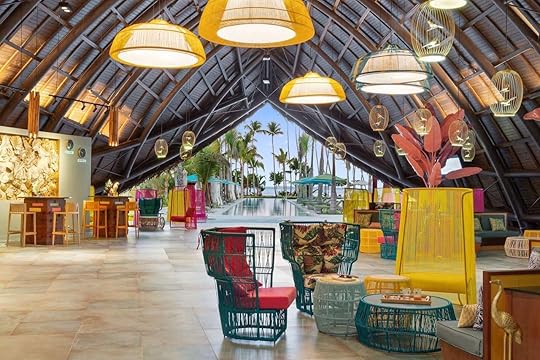
Photo: Club Med
For example, Club Med Resorts takes its environmental stewardship seriously, with 80 percent of its properties achieving Green Globe certification. When it opened a new resort and spa on the yet-unspoiled beaches of Miches in the Dominican Republic, Club Med used the opportunity to set an eco-conscious precedent for future developments in the area. It worked with local government agencies to perform an in-depth environmental impact study and enacted a tree-replanting program to save and replant the more than 2,000 trees that needed to be moved for construction. While all-inclusive resorts are not necessarily optimal for the local economy, we are glad to see the effort to save the removed trees.

Photo: Ocean House/Facebook
[image error]
Photo: Ocean House/Facebook
Farther north in the Canadian archipelago of Haida Gwaii, the floating Ocean House wellness resort is 100 percent Haida-owned with an environmental ethos rooted in its Native American heritage. Every aspect of the Ocean House wellness experience is guided by the Haida concept of yahguudang: respect for all living things and the interdependence that binds us. Its environmental stewardship efforts earned the property Sustainable Tourism Gold Certification in August 2018.

Photo: Andaz Mayakoba Resort Riviera Maya/Facebook
Many destinations invite guests to participate in conservation and environmental stewardship. At Hyatt’s Andaz Mayakoba Resort in Cancun, for instance, guests partake in the resort’s Reef Guardian experience to preserve Mayakoba’s coral reefs. Twice a week, groups kayak out to the reef and assist in planting new, live coral colonies while learning about the endangered coral from Reef Guardian experts. Coral preservation and propagation programs are also offered at other popular wellness resorts including Iberostar’s Punta Cana property, COMO Maalifuushi in the Maldives, and the Six Senses Ninh Van Bay resort in Vietnam.

Photo: Ted Turner Reserves/Facebook
Back on dry land, guests of Vermejo, a Ted Turner reserve set on more than 500,000 acres of New Mexico wilderness, can partake in annual elk and bison hunts to keep game populations at biologist-specified levels that help prevent overgrazing and keep the natural ecosystem in balance. Any meat that doesn’t get taken home is served for dinner by the resort’s expert culinary team. Which brings me to the next question we should be asking…
What food are they serving, and where does it come from?

Photo: Blackberry Mountain/Facebook
One of the surest signs that a wellness resort is serious about your health is when its menu is full of local, seasonal, and mostly plant-based ingredients. Not only does local food require fewer CO2 emissions for transportation, but it’s also better for you. The closer the food is to its original source when you eat it, the more nutrients it will provide. Local also means better flavor, which is why the best chefs have strong relationships with the farmers and purveyors in their community.
[image error]
Photo: Blackberry Mountain/Facebook

Photo: Blackberry Mountain/Facebook
The food at Blackberry Mountain wellness retreat is a perfect example. In partnership with its award-winning sister restaurant, Blackberry Farm, the retreat’s restaurants are fiercely committed to cooking up locally sourced ingredients at every meal, and foodie travelers are taking note.

Photo: The BodyHoliday/Facebook
But perhaps the best example of locally sourced food at a wellness retreat is at The BodyHoliday in St. Lucia, which takes farm-to-table a step further by having guests do the farming. Here, groups are led through the on-site regenerative garden by the hotel’s Environment and Ecosystem Leaders, Damian and Ratoya Adjodha. They share nutrition information and cultural context for each ingredient as you harvest, helping guests connect more deeply to the meal they then help create in the nearby kitchen. This experience of cultural exchange is another important benefit to eating local when traveling.
While plant-based is generally the more eco-friendly choice, it’s okay to eat meat occasionally as long as it’s — you guessed it — locally sourced. If you’re in the Caribbean, for example, you can skip the salmon knowing there are plenty of fresh, local seafood options available. At the carbon-neutral Bucuti & Tara Beach Resort, you’ll find a delicious lionfish ceviche on the menu, part of the resort’s efforts to combat the invasive population in its surrounding waters.
Of course, every meal you enjoy on vacation is bound to generate some amount of waste, which is why the last question to ask when booking your next wellness retreat is…
What steps are they taking to minimize waste?
When it comes to what we eat, we must also pay attention to what we throw out. And hotels and resorts are getting creative in order to solve the environmental scourge caused by food waste. At the Clarion Hotel in downtown Oslo, intentionally small plates are used at the breakfast buffet to prevent guests from loading their plates with food they won’t eat. In addition, new technology in food-waste analysis is being used by the Club Med in Punta Cana (and soon, other resorts in its portfolio) to more accurately predict how much of certain foods guests are eating, which can prevent the hotel from over-ordering its next supply. When it comes to mitigating emissions from food waste and sourcing, Zero Foodprint is helping restaurants become carbon neutral via a one percent fee added to patrons’ checks, which is used to help farmers implement practices that store carbon and improve soil health.
Beyond food waste, the use of single-use plastics by hotels and resorts can result in billions of pounds of trash per year. To address the issue, hotel groups like Hyatt, Marriott, Club Med, and Intercontinental Hotel Group have committed to reducing or eliminating single-use plastics from their properties. Instead, you’ll find straws and spoons made from avocado pits, or bulk-size toiletries replacing small, single-use bottles.
While it’s encouraging to see these efforts by major hospitality companies, it would be nice to have a way of recognizing them, right? That’s where Green Building Certification Inc. (GBCI), the same accrediting body responsible for LEED Certification, can help. Its plethora of certifications is helping travelers easily distinguish which properties are making serious efforts to reduce waste. For instance, The Hyatt Regency Maui Resort & Spa is one of the first hospitality companies to pursue GBCI’s TRUE (Total Resource Use and Efficiency) Zero Waste certification. To achieve this, properties must have more than 90 percent waste diversion from landfill, incineration, and the environment. In the last year, the Hyatt Regency Maui nearly doubled its landfill diversion from 38 percent to 75 percent.
Gone are the days that a simple towel rewash program was enough to warrant a sustainable stamp of approval. In order to make an actual dent in climate change, eco-conscious wellness hotels are elevating the status quo for destination management, food sourcing, and waste reduction. Keeping these three questions in mind before you book your future wellness retreat will ensure a much healthier experience for you and the planet. 
More like this Sustainability How to travel in Japan sustainably
The post Here’s what eco-friendly wellness travel will look like in the future appeared first on Matador Network.

5 road biking safety tips for bikers
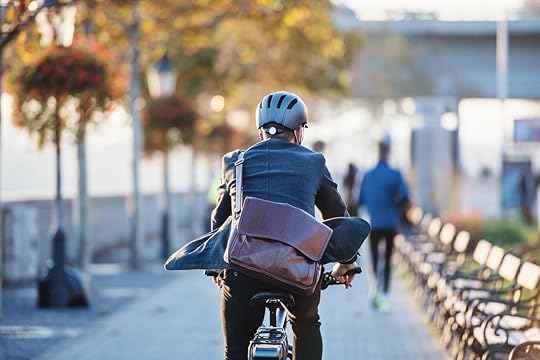
Maybe you’re commuting to work or pedaling around town, or maybe you’ve become more aware of your carbon footprint and are looking for a greener alternative to car travel. Whatever your reason, it’s time to bust out those two wheels. (And, now, the roads are emptier than ever.)
Biking in all its forms is good for your health and for the planet’s, but it does require a level of know-how to safely navigate the streets. Here’s how to stay safe and smart on two wheels.
1. A helmet and lights are the bare necessities.

Photo: connel/Shutterstock
A helmet may cramp your style but it keeps you alive, as do front and rear lights — front for you to see, rear so others can see you. Reflectors either on your bike or as part of your clothing are a good precaution to take, too.
Additional gear you’ll want include a transit bag or panniers that fix to the side of your bike to carry work gear, groceries, or whatever else you need to lug around; a water bottle; multi-tool; and sunscreen. And, in the age of COVID-19, a face mask is also a necessity.
2. Know how to work an air pump.
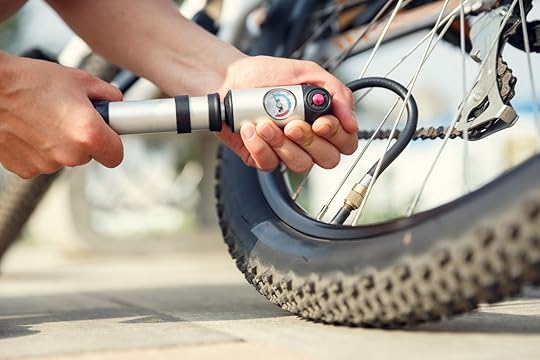
Photo: Kartinkin77/Shutterstock
If biking is a regular mode of transportation for you, think of it just like driving: You’ll need to be prepared for emergencies. Consider carrying around, or at least owning, a miniature pump and a travel tool kit. Travel pumps like this one from Topeak are affordable and easy to pack. Spare tubes, tire levers, and a regular-sized pump are other additions to your garage to avoid depending on (possibly closed) bike shops and stops to take care of minor adjustments.
Also important, learn how to change a tire. The best way to do this is to sign up for a bicycle maintenance class at a local shop or community college. However, in a pinch, just type “how to change a tire on (bike model)” into YouTube and do your best to follow along with the video. You’ll need tire levers for this, preferably ones not made out of thin plastic.
3. Plan and learn your route
[image error]
Photo: AsiaTravel/Shutterstock
It’s a no-brainer to familiarize yourself with your city’s bike lanes; some cities even have bike-lane maps you can download. When you’re planning a route, get to know the lay of the land. You might want to test-ride it and come up with a backup plan as well, should traffic or construction hit.
Ideally, your route will follow streets with bike lanes and utilize any bike paths, paved trails, and other bicycle-specific infrastructure available. A bike path may lead slightly out of the way, but it also saves you the time of stopping at red lights, which can actually shave a few minutes off your commute.
Apps like Bike Hub and Strava are designed to plan and track rides, but if you’re not worried about compiling data from each ride, the bike feature on Google Maps should do just fine for routing — just be sure you modify the directions for cycling. Shove your phone in a holder or an armband and let it lead the way. This could help you be confident, and confident riders make everyone less nervous.
4. Stay predictable, as well as responsible and alert.
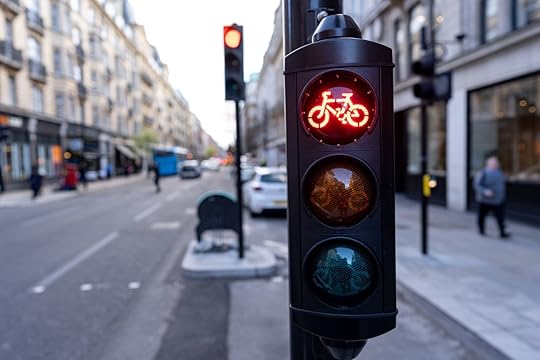
Photo: Georgios Karkavitsas/Shutterstock
Though it goes without saying, obey the rules everyone knows and expects of you. Ride with traffic (in the United States and Canada this means on the right side of the road), use arm signals, don’t swerve, stop at traffic lights — you get it. Cyclists are also required to stop at stop signs. The fewer surprises, the better your odds of staying safe. Look for tail lights, use the bike lane, yield to pedestrians, and make noise if you feel it necessary.
It’s paramount that you’re able to hear emergency sirens, oncoming cars, and the like. If you really can’t get over this, at least leave one ear headphone-free.
5. Ride like every driver is on their cell phone with a screaming child in the backseat.
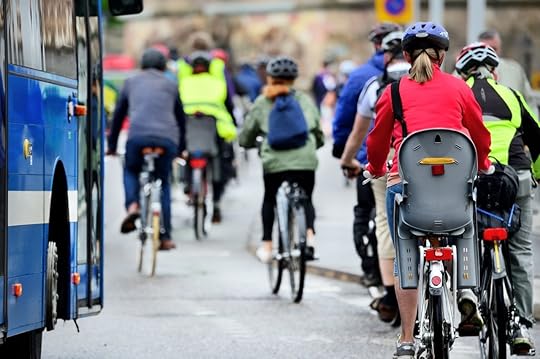
Photo: connel/Shutterstock
Seriously. Unfortunately, as a cyclist, it’s your job to be on the defensive — a two-ton vehicle will always best you in any altercation. Try to make eye contact with drivers when making a left turn, and feel free to wave your arms about if you’re not sure you’re seen. If there’s no bike lane, ride like you’re a car, taking up plenty of room — that way you’ll have better odds of being seen.
You’re a vehicle on the road, and you have a reaction time just like everyone else. Stay at least one bike’s length away for every five miles per hour when moving, and leave extra space between you and stopped vehicles. You never know.
Give yourself space side to side, too. Don’t hug the curb. You deserve access to the road just as cars do. Ride in single-file; to not do so is often illegal.
And, finally, leave the sidewalk for the people out walking. You’re a master of the road now. 
More like this Cycling Bicycles are in short supply right now. Here’s where to find one.
The post 5 tips for staying safe while bike commuting and road riding appeared first on Matador Network.

Ella Jones elected Ferguson mayor

On Tuesday, Councilwoman Ella Jones was elected as the first-ever Black mayor of Ferguson, Missouri. The city became known worldwide in August 2014 after unarmed Black teenager Michael Brown was shot there by a white police officer, sparking protests throughout the United States.
The historic election comes at a time when demonstrations against police brutality have erupted in every single US state following the murder of George Floyd, an unarmed Black man.
Jones’ election marks an important shift in Ferguson’s leadership, as just six years ago there was only one Black city councilmember. Now four of six councilmembers are Black, Jones included.
This was the second time Jones ran for mayor of Ferguson, having lost in 2017. In this election, she won 54 percent of the vote over Councilwoman Heather Robinett, who received 46 percent. Both Jones and Robinett had pledged to support the goals of peaceful protestors upset by the murder of George Floyd.
After her victory, Jones told St. Louis Public Radio, “I’ve got work to do — because when you’re an African-American woman, they require more of you than they require of my counterpart.”
Jones is also the first woman to serve as Ferguson’s mayor. 
More like this News How to support Black Lives Matter protests if you can’t be there in person
The post Ferguson, MO, just elected its first Black mayor appeared first on Matador Network.

Poachers kill 6 elephants, Ethiopia

Poachers killed at least six elephants in a single day last week in Ethiopia, after the animals ventured outside the country’s protected Mago National Park in search of water. An additional two elephants are thought to have been killed in the attack, though their deaths have not been confirmed. The incident marks the first time local officials have experienced such a mass killing of elephants — in 2019, the Ethiopian government documented no more than 10 killings throughout the entire year.
“The poachers then removed all the tusks from the elephants. It was a mass killing. We haven’t seen anything like this before,” said Ganabul Bulmi, chief warden of the park, to reporters.
In recent months, poachers have taken the opportunity to strike when opportunity allows. The lack of visitors has increased opportunities for poachers to strike, and with authorities diverting attention to the COVID-19 pandemic, there is little chance of them being caught.
Ethiopia’s elephant population faces an imminent threat from poachers. For years, the animals have been targeted for their ivory tusks, which are sold on the black market. The country’s elephant population has dwindled from over 10,000 in the 1970s to less than 3,000 elephants today. About 400,000 elephants remain in Africa, down from an estimated 700,000 in 2014, according to the World Wildlife Fund. 
More like this Travel Retrace Jane Goodall’s steps through Gombe Stream National Park, chimpanzees and all
The post Poachers kill six elephants in a single day in Ethiopia appeared first on Matador Network.

UK ready to welcome millions from HK
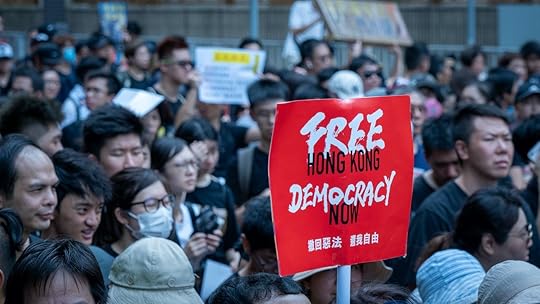
As China appears set to impose a new security law depriving Hong Kong of its freedom of speech and assembly, its independent judiciary, and demoratic rights, UK Prime Minister Boris Johnson is offering a potential escape route to people from Hong Kong. Johnson vowed to make one of the biggest changes in the history of the British visa system, offering a path to UK citizenship to nearly 3 million Hong Kong residents.
There are currently 350,000 Hong Kong residents who hold a British overseas passport and 2.5 million more are eligible for one. They may be able to obtain 12-month renewable visas to live and work in the UK.
“If China imposes its national security law,” said Johnson, “the British Government will change our immigration rules and allow any holder of these passports from Hong Kong to come to the UK for a renewable period of 12 months and be given further immigration rights, including the right to work, which could place them on a route to citizenship. This would amount to one of the biggest changes in our visa system in British history.”
Dominic Raab, the UK’s foreign secretary, told the House of Commons he hopes China will reconsider its decision. “There is a moment for China to step back from the brink and respect Hong Kong’s autonomy and respect China’s own international obligations,” he said.
In the meantime, Raab told MPs that the government is currently looking at several options that would provide a pathway to UK citizenship for Hong Kong residents.
“If China proceeds to justify their fears,” said Johnson, “then Britain could not in good conscience shrug our shoulders and walk away; instead we will honour our obligations and provide an alternative.” 
More like this Travel What the changing laws in Hong Kong mean for travelers
The post UK to offer path to citizenship to 3 million people from Hong Kong appeared first on Matador Network.
[image error]
How to support Black Lives Matter
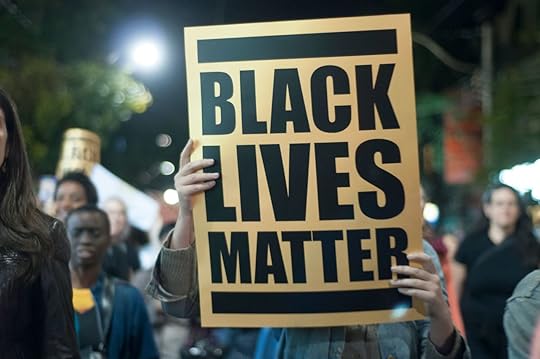
To talk about Black Lives Matter is to acknowledge a movement. It’s a movement that implicitly recognizes the organization that heaved its mission onto the national stage, yet it’s one that’s also come to represent the efforts of countless groups and individuals who are unaffiliated, albeit allied, with the Black Lives Matter Foundation.
Black Lives Matter was founded in 2013 in the wake of Trayvon Martin’s murder and his shooter George Zimmerman’s acquittal. Reports on the recent protests decrying George Floyd’s murder at the hands of Minneapolis police have remarked that the movement has gone global, recognizing the worldwide demonstrations being staged in solidarity with today’s activists. Yet since 2013, Black Lives Matter has grown a global network with upward of 40 chapters across the US, UK, and Canada, to say nothing of its individual supporters around the world.
It’s easy to conflate the Black Lives Matter movement with the organization that inspired its name. As the flow of protests across the country and beyond begin to ebb, however, it’s important to remember that the organization will still need our support. Take to the streets now if you’re able. Then, when you’re no longer marching, take your next cues from the Black Lives Matters pioneers who rallied us all in the first place.
Even now, there’s work to be done outside of the protests that are sweeping the nation. These are the issues Black Lives Matter is calling on us to prop up. And this is how to answer that call.
Combatting COVID-19 in Black communities
Statistics show that Black Americans are suffering the direct consequences of COVID-19 in the US. A recent CDC report examining hospitalization rates across 14 states suggests that the Black community has been disproportionately affected, representing just 18 percent of the COVID-NET catchment population in question but 33 percent of hospitalized patients.
Data released by New York City’s health department shows that infection rates for both hospitalized and non-hospitalized patients are highest among Black New Yorkers. COVID-19-related fatalities are also highest within the Black community, which represents 92.3 deaths out of every 100,000 confirmed cases compared to 74.3 fatalities among Hispanic and Latino residents and 45.2 deaths among white residents.
Since the pandemic struck, BLM has been devoted to educating supporters on the racial disparity of COVID-19’s impact and providing resources for the minority groups that have been most affected, chief among them Black Americans. Beyond promoting general health and safety tips, the BLM website has compiled a list of resources to aid in filing for unemployment and other benefits, applying for federal loans as a small-business owner, and obtaining relief grants. The New York State Office of Mental Health’s support hotline is also spotlighted while a map of COVID-19 resources provides links to both statewide and county-specific updates on the COVID-19 response across the US.
BLM is currently circulating two petitions to advocate for Black Americans during the pandemic. The first calls for race-related data on COVID-19. “We will be hit the hardest,” the petition reads, demanding that both the government and CDC collect and release racial demographic data and provide resources to benefit the Black community. It also compels the CARES Act, which Congress passed to provide financial assistance to working Americans and small businesses, to improve its commitment to benefiting those in need.
The second petition calls for a superior government response in general. Demands include passing an emergency relief package aimed at mass testing and security for homeless and poor populations, providing testing and protection for incarcerated citizens, increasing unemployment and SNAP food benefits, legislating paid sick leave for workers, and suspending evictions and utility shut-offs during the pandemic.
Support Black Americans during COVID-19 by adding your name to both petitions, and opt in to email updates to stay apprised of the ways in which you can help going forward. For more information on BLM’s fight to support Black communities during the COVID-19 crisis, as well as more context on why they’re suffering at the hands of both the virus and American healthcare, read and share these vital words from BLM’s Managing Director Kailee Scales.
Taking back the polls with the #WhatMattersMost2020 campaign
Exercising our right to vote is among the most important ways we can lend our support to Black Americans. In an effort to encourage voter turnout during this year’s presidential election, as well as elevate candidates that are supportive of the BLM cause, the organization has spearheaded the #WhatMatters2020 campaign.
The campaign’s mission is to represent the issues that impact most Black Americans, among them criminal justice reform, access to healthcare and education, voter suppression, and police brutality. It also aims to spotlight injustices that affect underrepresented populations more generally, as well as the wider community, such as LGBTQ and environmental issues.
Three main campaign goals are outlined on the BLM website: enable the Black community to become more active in the presidential election, educate voters on the issues that impact them and the ways in which candidates pledge to combat those issues, and up voter registration to ensure underserved communities are represented at the polls. This not only means galvanizing youth and minority voters but also encouraging allies to vote responsibly.
As with any online campaign, the most important thing BLM advocates can do to support the #WhatMatters2020 cause is to spread the word on social media. Be politically active on Facebook and Twitter, and use the #WhatMatters2020 hashtag liberally.
As for seeing the campaign’s goals realized, nothing matters more than your vote. Register to vote here, pledge to vote here, and sign up to receive BLM’s updates on the 2020 election here.
Educating yourself on BLM activism
BLM education is twofold: It requires a commitment to learning from the organization’s leaders and heeding the BLM’s advice on becoming a productive advocate.
The recently launched What Matters docuseries spotlights prominent voices within the organization, as well as interviews with politicians, professors, doctors, attorneys, and other figures close to the cause. Recent episodes have focused on COVID-19, from the media’s responsibility toward accurate reporting to health disparities in Black communities, as well as on March 13 and other topical issues. Keep up with What Matters conversations on Vimeo, YouTube, Spotify, or the Apple or Google Podcasts.
BLM also elevates community members through its Activist Shorts video series. Talks with leaders from BLM’s Chicago, Lansing, Los Angeles, and Toronto chapters are currently featured on the BLM website, along with a video address on the future of the movement from Co-Founder and Strategic Advisor Patrisse Khan-Cullors.
Understanding the complexities that underpin the BLM movement is not easy. Neither is translating insight into action as simple as waving a protest sign. As much as creating a fleet of activists is central to BLM’s mission, encouraging responsible, productive representatives to protect both the cause and themselves is a primary goal. If and when you decide to start a dialogue, organize an event, or take to the streets, familiarize yourself with BLM’s toolkits first.
These toolkits are designed to be resources for activists of various backgrounds. Some provide guidance on institutionalizing healing justice and preserving well-being in the face of confrontation, providing tips on preparing for, engaging in, and finding resolution after direct action. Others are dedicated to resolving conflict between BLM chapters. Some were designed to teach white people how to join discussions about racial issues. Others were created to unite Black and non-Black activists in dialogue, ideas, and action.
For those interested in becoming involved with BLM more permanently, studying up on the organization’s resources for appropriate campaigning should be a priority.
Other ways to get involved
Support for BLM takes many shapes. Spreading the word helps. Donations toward the organization’s “fight to end state-sanctioned violence, liberate Black people, and end white supremacy forever” are appreciated. Buying, and sporting, BLM merchandise is another way to make both a financial contribution and a statement in support of the cause.
Specific calls to action are also levied as necessary. BLM often rallies support through petitions, such as the ongoing #DefundThePolice and #InvestInCommunities, which calls for radical national police reform and solutions that value the sanctity of Black lives. Currently, the organization is also asking supporters to help stop the spread of disinformation about BLM.
There are a number of ways to get involved with BLM even after the current protests end. Any and all involvement helps, but if you’re serious about becoming part of the global BLM network, you may want to consider joining a chapter. Or, better yet, think about starting one yourself. 
More like this Books Purchase your new reading list from these Black-owned bookstores, not Amazon
The post #WhatMatters2020: supporting Black Lives Matter beyond right now appeared first on Matador Network.

Matador Network's Blog
- Matador Network's profile
- 6 followers



